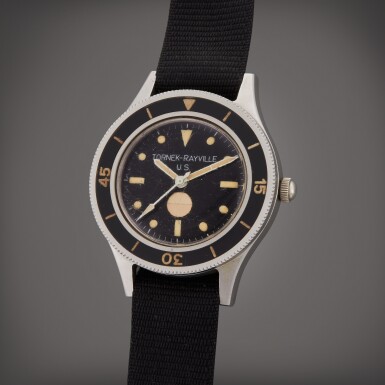
Property from the Original Owner, Lt. Brian S. Economy
Tornek Rayville
Reference TR-900 | A stainless steel anti-magnetic diver's wristwatch with humidity indicator, Made for the U.S. Navy, Circa 1966
Auction Closed
June 9, 05:37 PM GMT
Estimate
80,000 - 120,000 USD
Lot Details
Description
Reference TR-900
A stainless steel anti-magnetic diver's wristwatch with humidity indicator, Made for the U.S. Navy, Circa 1966
Dial: black
Caliber: cal. AS 1361 automatic, 17 jewels
Case: stainless steel, screw down case back
Case number: 0452
Closure: nylon strap with brass buckle
Size: 41 mm diameter
Signed: case, dial and movement
Box: no
Papers: no
Accessories: Double hose closed circuit regulator, Cressi-sub scuba mask, Department of Navy document denoting Brian S. Economy's SCUBA certifications, letter from the President of the United States appointing Brian S. Economy as Lieutenant of the United States Navy, dog tags, liberation of Kuwait medal and ribbon from the Kingdom of Saudi Arabia, various photographs, name tape, rank insignia, Lieutenant's cover in digital camouflage, monogrammed pens, rank and qualification pins, and rank insignia
In 1961, the US government, under contract MIL-W-22176A, was looking to supply their sailors with a watch that would withstand the rigors of modern SCUBA diving. Many manufacturers attempted to win the contract, but due to the numerous and specific demands set forth by the Navy, a watch supplied by Allen Tornek was the only one to meet them all. The Tornek-Rayville TR-900 was more than meets the eye, however, it was an incognito Blancpain Fifty Fathoms.
Several watches were to be tested by the navy, each as hopeful to win the contract to supply the first UDT (underwater demolition team) divers. Namely the Enicar Sea Pearl, Rolex Submariner, and Blancpain Fifty Fathoms. The testing procedure was brutal. The watches would be dropped from great heights, frozen solid, exposed to high temperatures, and stomped into sandy beaches, to name a few.
Not only was the Blancpain the only watch to meet all of the criteria set forth, of the three watches to be abused in The Navy’s tests, it was the only one still ticking when all was said and done. But, how did a Blancpain come to be branded Tornek-Rayville? The most difficult standard to be met was the “Buy American Act” of 1933, which required that military goods be procured from within the U.S. In order to circumvent this requirement, Allen Tornek would import watches from Rayville through his U.S.-based company. As for “Rayville,” that was merely an anagram/americanization of Villeret, the town in Switzerland where Blancpain resides.
EOD tech Lt. Brian S. Economy wouldn’t be issued this particular TR-900 until he was at the Naval Dive and Salvage training center in 1988, some 22 years after the first TR-900 was issued. Visible on the 9:00 side of the case, are the “low mu” engravings that signified that the watch had passed “magnetic and acoustic signature control for mine warfare (MIW) (U)" testing in July '82 and again in June '87. The specifics of this testing process are still classified. The same low mu symbol can also be seen on the double-hose, closed circuit regulator also included in the lot.
During Economy’s service, the watch faithfully kept time on deployment in Central America, Iraq, and Somalia. Economy also wore this watch while working with his trained, sea mine-hunting dolphin named Nino.
